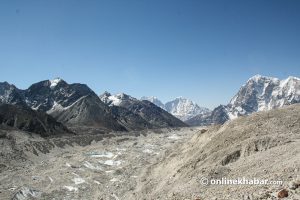
When botanist Bharat Babu Shrestha visited Jalthal of Jhapa district three weeks ago, he was surprised. The Tribhuvan University associate professor found a new plant spreading across the village.
In the past two decades of his career, Shrestha, who has concentrated on ‘alien’ plants in Nepal, has discovered new plants some of which have already ‘naturalised’ in the Nepali farmland and forests. Some of them have ‘invaded’ the natural biodiversity of the place and threatened the health of native plants and existing biodiversity.
“The one I saw in Jalthal recently must be another invasive alien plant as the presence of such plants is increasing in the country,” Shrestha says, though the plant is yet to be recognised officially.
His confidence in labelling the new plant ‘invasive’ without verifying the data from other places partly stems from recent research. which concludes that climate change amplifies plant invasion hotspots in Nepal.
By analysing a wide range of data on 24 invasive plants collected from different parts of the country in five years, the research predicts that 75 percent of currently available invasive plants are likely to expand their ‘invasion’ of natural landscape whereas many new ‘invaders’ will also emerge.
Alien and invasive plants in Nepal
Various studies have found that there are around 250 alien species, including plants and animals, in Nepal. Among the 250 species, 180 are plants.
Of the 180 alien plants, around 150 have not caused any threat to the native biodiversity, according to researchers. “For example, potato, tomato, chilli and marigold are not native to Nepal. They were brought here for specific purposes,” Shrestha informs, “Over centuries, these plants have already made their place in the natural system without affecting the native plants here. In botany, we hence call them naturalised plants.”

While people continue to bring in ‘alien’ plants to their environment, all the plants do not naturalise as planned. Rather, they begin invading the habitat of other species and threaten the natural ecosystem. “Sometimes, people bring them for decorative purposes and other uses, but they continue to multiply and cause problems,” he explains, “Lantana flowers, for example, were brought to Nepal as ornamental flowers, but now they are found almost everywhere in Kathmandu these days. Hyacinths were brought to decorate aquariums, but now they threaten the beauty of Phewa Lake in Pokhara. Do you know how many millions of rupees are spent to destroy hyacinths in Phewa Lake every year?”
According to Shrestha, 26 invasive plants are found in Nepal currently. Among them, four (Chromolaena odorata, Eichhornia crassipes, Lantana camara and Mikania micrantha) are among the 100 worst invasive species of the world. Experts keep on updating the list. While a few plants are removed from the list if they disappear, most of the times new items are added.
The climate connection
One of the main factors behind the continuous increase in the presence of invasive plants in Nepal is climate change, Shrestha claims based on the research project that he and another botanist, Uttam Babu Shrestha jointly concluded recently.
“Due to climate change, the average temperature of hilly and mountainous regions of Nepal is likely to increase in the upcoming years,” he explains the key finding of the research, “Most of the invasive plants currently found in Nepal are restricted to the Terai and the lower hills only as these regions boast subtropical and tropical climate suitable for the plants. But now, the temperature of higher elevations will also increase, becoming suitable for invasive plants.”

The research notes that invasive plants are not found in the subalpine region of Nepal between 3,000 and 4,000-metre altitude levels till now, but these regions will be ready to host the invaders before 2050. “The invasion hotspots as predicted by our models will expand towards the higher elevation areas, especially in the temperate and subalpine regions, making these regions susceptible to biological invasions under future climate. The expansion on invasion hotspots will also be visible in the tropical region,” the research report reads before citing previous research, “At high‐elevation regions, the impact of climate change is likely to be more severe than in low elevation, as the magnitude of temperature change is greater in those areas.”
The development dynamics
Besides climate change, another significant factor that might lead to expansion of hotspots of invasive plants in Nepal is the development of physical infrastructures in remote mountainous regions of the country, according to Shrestha. “Roads bring various facilities to the villages, but they will also become pathways for invasive plants,” he says, “When you destroy the natural environment for whatever purpose, it becomes easier for invasive plants to expand. This is a common characteristic of all invasive plants in the world.”
Constructing roads is not possible without clearing existing forestlands or cultivations. In that process, many clearings are left empty; but within months, they are seen covered by the invasive plants, he informs. “This is why, when you travel on a cable car to Chandragiri hill, you can see a parallel line of ‘kalo banmara’ (Ageratina adenophora) just below you.”
The report reads, “With tourism industry predicted to be grown in the future, human mobility, trade and transport will increase significantly. This may promote the dispersal of invasive alien plants from lowlands to high‐elevation regions and to new areas in the lowlands.”
Remedies
With this conclusion, the research is not suggesting that the development activities should stop. Instead, it advocates for proper monitoring and management of the invasive plants to control their expansion before it is too late.

Biological invasion is a global problem, it requires global collaboration to effectively fight with it, Shrestha suggests, adding, Nepal, however, could take some immediate measures to control the expansion of invasive plants and reduce their adverse impacts on the natural ecosystem. “Unlike the deliberate import of lantana and hyacinth, most invasive plants come to Nepal without the importer’s knowledge these days. For example, when you import a new species of corn or rice, you also bring seeds of other weeds along with them.”
Therefore, he recommends that the country’s quarantine system should be strengthened to control the expansion. “This way, we can at least control the expansion of new species, though controlling already expanded plants is more difficult.”
Among the plants which have already ‘invaded’ the nature also, he suggests an early response could help a lot. “If you want to control the expansion of the plant I saw in Jhapa recently, it will not be as difficult as controlling hyacinths of Phewa Lake,” he says, “Biological invasion is just like cancer. The sooner you give the treatment, the easier and more effective it is.”
Shrestha says the government should listen to researchers and experts in order to identify and control these plants. For that, he recommends some policy and institutional reforms. “Many things have not happened now because it is not clear who is responsible to control invasive plants,” he says, “The government should formulate a strategy and assign an agency to work on the issue.” The researcher informs that the government had prepared a draft of the strategy three years ago, but it has not been endorsed yet.
Photos: Bharat Babu Shrestha

























